1902 - 1919 Aviation
arrives in the Isle of Man
In 1902 the first aerial
vehicle was to be seen in the Isle of Man when a Royal Navy gas balloon
measuring 60 ft high by 45 ft diameter, was flown from Peveril Square in
Douglas for a free flight ending in Dumfriesshire, Scotland. The following
year, on December 17th 1903, Orville Wright conducted the first ever flight
by a powered aircraft at Kitty Hawk, North Carolina, USA.
There was to be no further
aerial activity in the Isle of Man until July 1911 when a temporary aerodrome
was established in Nobles Park, Douglas for demonstration flying
by two early flying machines, a Farman and a Bleriot, the aircraft having
been shipped to the island by the IOM Steam Packet. In the event
only the Farman actually took to the air, as the Bleriot had been damaged
in transit. In August 1912 the Nobles Park aerodrome was activated
again when Gustave Hamel conducted demonstration flights in a Morane Saulnier,
including the island's first 'Air Mail' flight, from Douglas to Peel!
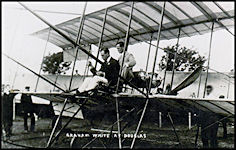 Farman Biplane
Farman Biplane
|
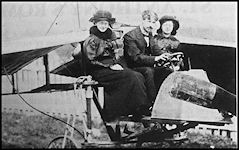 Bleriot Monoplane
Bleriot Monoplane
|
In August 1914 an aerodrome
was established on Queen's Promenade, Douglas, with a Bleriot monoplane
using the beach for takeoff and landing and an Avro 504 float plane operating
from the water, being hauled up on to the promenade at the end of the day.
Both these aircraft gave pleasure flights to the public which proved a
great success. As with the previous visiting aircraft, they arrived to
and departed from the island courtesy of the isle of Man Steam Packet.
During World War One, great strides were taken in the development of aircraft
and the first flight 'across the water' were made to the island, by Short
184 seaplanes operated by the Royal Navy. They operated from Lake Windermere
in Cumbria and carried mail whilst also looking out for German U-Boat activity
in the Irish Sea. After the war the first flight to the island by a Manxman
was carried out by Captain Elgie Jefferson who flew a Bristol Fighter from
Hooton Park in Cheshire, landing at Great Meadow near Castletown in January
1919 before continuing the next day to Stranraer, Scotland.
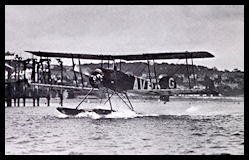 Avro 504 Float-plane
Avro 504 Float-plane
|
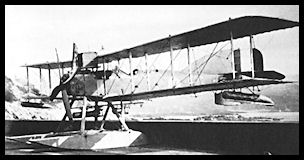 Royal Navy Short
184 Seaplane
Royal Navy Short
184 Seaplane
|
In the Spring of 1919
the Queen's Promenade aerodrome was active again for pleasure flying with
Avro 504s and in July of that year Captain Howard Pixton made what is regarded
as the first commercial flight to the island. Using an Avro 504 float plane
he flew copies of the 'Daily News' from Windermere for sale to holidaymakers.
Flights continued for two weeks and passengers could be carried for the
price of 10 guineas. The following year there was more pleasure flying
from Douglas beach but after objections and a petition signed by 20 people,
permission was withdrawn and there was to be no more flying from the island
until 1925 during the TT races when a de-Havilland DH9 flew copies of the
'Motorcycle News' over, landing on Douglas Head. This became a regular
event over the next few years.
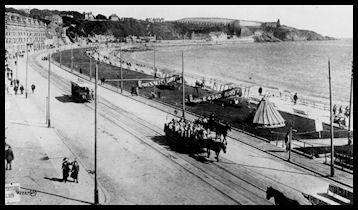 Avro 504s on Queen's
Promenade in 1919
Avro 504s on Queen's
Promenade in 1919
|
1928 - First flights at Ronaldsway
The first use of Ronaldsway
as an aerodrome occurred on June 5th 1928 when Captain Olley, flying an
Imperial Airways Handley Page HP27 Hampstead, G-EBLE, landed in a large
field on Ronaldsway farm bringing in the 'The Motorcycle' for TT visitors.
The Hampstead was a large three motor biplane and after delivering the
papers, was made available for pleasure flying from Ronaldsway. The aircraft
had a wingspan of 75 ft and at 60 ft in length could carry up to 14 passengers
in its cabin. As was usual in those days, the pilot and mechanic sat outside
and braved the elements! During TT the following year Ronaldsway was used
again for both 'The Motorcycle' and also the 'Daily Mail' during the TT
race period, the latter being flown in by a DH61 Giant Moth. The Summer
of 1929 also saw the arrival of Sir Alan Cobham who was touring Great Britain
to promote aviation. He arrived at Ronaldsway in DH61 Giant Moth G-AAEV
'Youth of Britain' on August 2nd from Blackpool, and carried out a series
of demonstration flights, mainly to young people from the island. He also
encouraged the establishment of a permanent aerodrome for the Isle of Man.
In April 1933 two famous aviators visited Ronaldsway, Amy Johnson, flying
DH60G Moth G-ABVW 'Jason 4' and her husband Jim Mollison, flying DH80A
Puss Moth G-ACAB 'Desert Cloud'.
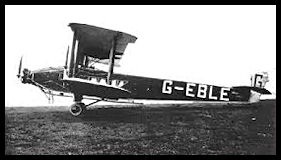 Handley Page HP27
Hampstead G-EBLE
Handley Page HP27
Hampstead G-EBLE
|
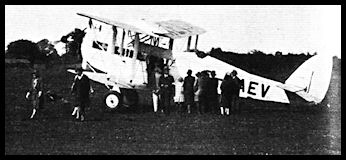 de-Havilland DH61
Giant Moth G-AAEV
de-Havilland DH61
Giant Moth G-AAEV
|
Manx
Aviation and ATC in the 1930s
|